- Last Updated: December 16th, 2025
Key Takeaways
The manufacturing of PCBs was banned in the United States in 1979 due to their toxic properties and environmental persistence, yet workers may still encounter PCBs in older equipment or during cleanup operations.
Occupational exposure to PCBs is of particular concern as they are considered to be probable human carcinogens.
Ensuring safety from toxic substances like PCBs in the workplace is mandated by regulations.
Overview of the Occupational Exposure to PCBs
On this page, we’ll discuss an overview of occupational exposure to PCBs, managing risks of exposure to PCBs in the workplace, safe PCB waste handling practices to prevent occupational exposure to PCBs, and much more.
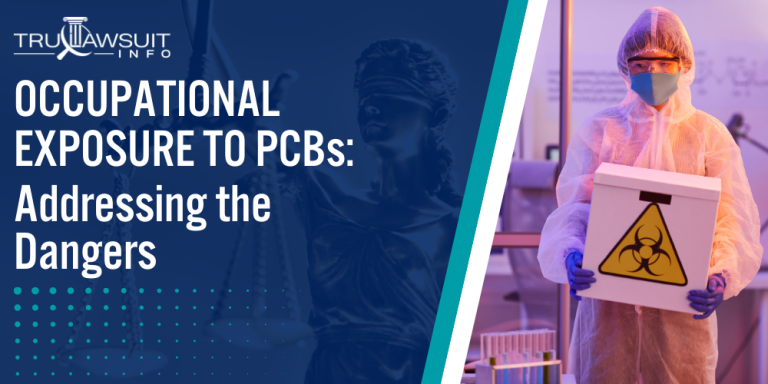
Intro to Exposure to PCBs
Here’s how PCBs can still present hazards in the workplace:
- Environmental Exposure: Even though PCBs are no longer manufactured, they can persist in the environment and contaminate workplace settings.
- PCB Exposures in the Workplace: Workers in industries dealing with old electrical devices or buildings may be exposed to PCBs through inhalation, skin contact, or ingestion.
- Human Exposure Risks: Continued exposure to PCBs can lead to a variety of health risks, including liver damage and increased risk of cancer.
- Managing Exposure: Safety protocols, including proper handling, use of personal protective equipment (PPE), and regular monitoring, are essential to minimize worker exposure to PCBs.
If you or a loved one has experienced adverse health conditions after being subjected to PCB exposure, you may qualify to pursue compensation.
Contact TruLawsuit Info using the chat on this page to receive an instant case evaluation to determine if you qualify to file a PCB lawsuit today.
Managing Risks of Exposure to PCBs in the Workplace
Effective management of PCB exposure in the workplace is essential to ensure occupational safety.
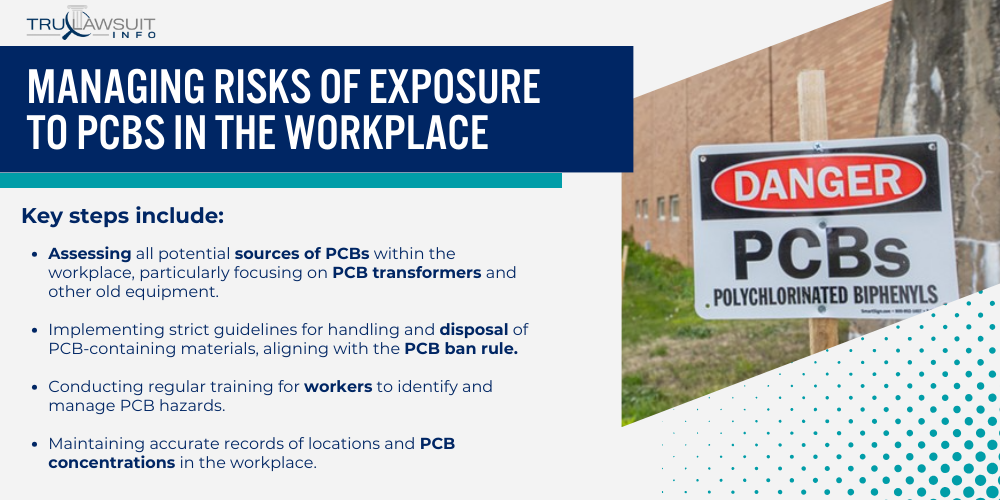
This section outlines the strategies and protective measures that can be undertaken by facilities dealing with PCB-containing equipment, such as electrical transformers.
Enhancing Safety Protocols Against Exposure to PCBs
Safety protocols are fundamental in reducing workplace exposure to PCBs.
They serve to minimize the risk of health effects associated with PCBs.
Key steps include:
- Assessing all potential sources of PCBs within the workplace, particularly focusing on PCB transformers and other old equipment.
- Implementing strict guidelines for handling and disposal of PCB-containing materials, aligning with the PCB ban rule.
- Conducting regular training for workers to identify and manage PCB hazards.
- Maintaining accurate records of locations and PCB concentrations in the workplace.
Protective Measures for Employees at Risk of PCB Exposure
Protective measures are crucial for employees who work in environments where they may be exposed to PCBs.
To safeguard these workers:
- Provide personal protective equipment (PPE), including respirators, gloves, and protective clothing.
- Implement health surveillance programs to monitor workers for signs of PCB exposure.
- Enforce hygiene practices, such as handwashing and showering after handling PCBs.
- Establish decontamination procedures for tools and work areas to prevent PCB spread.
FAST Guidelines for Minimizing Exposure to PCBs in Occupational Settings
The FAST guidelines (Find, Assess, Stabilize, and Track) offer a structured approach to managing PCB hazards in the workplace.
Steps involved:
- Find sources of PCBs, including any materials or equipment that predate the PCB manufacturing ban.
- Assess the risk of exposure through air, direct contact, or accidental ingestion.
- Stabilize the environment by securing any PCB-containing materials and preventing their release.
- Track and update PCB management plans as necessary, ensuring compliance with occupational safety standards and regulations.
Implementing these measures helps manage and mitigate the risks associated with PCB exposure in occupational settings, maintaining a safe workplace per occupational safety regulations and PCB disposal facilities standards.
Health Prioritization in Sites with PCB Exposure Risks
Health prioritization strategies are essential for safeguarding workers in workplaces where polychlorinated biphenyls (PCBs) pose risks.
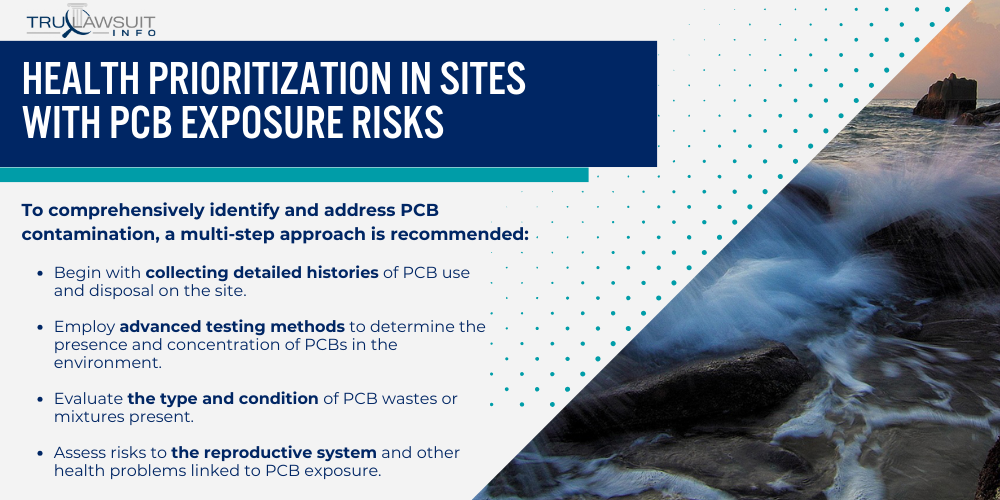
Targeted assessments, comprehensive cleanup plans, and rigorous worker safety certifications are key to managing the dangers of occupational exposure.
Conducting Thorough Assessments for PCB Exposure Risks
Effective site assessment is the first step in mitigating health risks associated with PCB exposure in industrial plant settings.
To comprehensively identify and address PCB contamination, a multi-step approach is recommended:
- Begin with collecting detailed histories of PCB use and disposal on the site.
- Employ advanced testing methods to determine the presence and concentration of PCBs in the environment.
- Evaluate the type and condition of PCB wastes or mixtures present.
- Assess risks to the reproductive system and other health problems linked to PCB exposure.
- Identify dietary exposure risks for workers, especially in sites located near food sources.
- Prioritize areas that are heavily contaminated for immediate attention.
Cleanup Plans to Reduce Occupational Exposure to PCBs
Strategic cleanup operations are crucial to eliminate or minimize exposure to PCBs at contaminated sites.
To effectively reduce occupational exposure to PCBs, implement the following cleanup plans:
- Formulate a systematic approach to address heavily contaminated zones.
- Incorporate safe handling and disposal procedures for PCB wastes.
- Integrate regular monitoring to track the effectiveness of cleanup efforts.
- Include measures for controlling dietary exposure among workers at the site.
Certifying Worker Safety in Environments with PCB Exposure
Maintaining a safe work environment requires ongoing efforts and vigilance, especially in the presence of hazardous substances like PCBs.
To effectively safeguard worker health in PCB environments, here are essential measures to implement:
- A comprehensive health and safety training program focused on PCB hazards.
- Provide and enforce the use of appropriate personal protective equipment (PPE) to minimize occupational exposure.
- Regular health screenings for conditions associated with PCB exposure should be conducted.
- Secure certifications and routine audits to ensure compliance with standards and regulations for handling PCB mixtures and wastes.
Reducing Occupational Exposure to PCBs Through Effective Strategies
Efforts to minimize occupational exposure to PCBs are vital due to the potential for increased risk of health issues upon exposure.
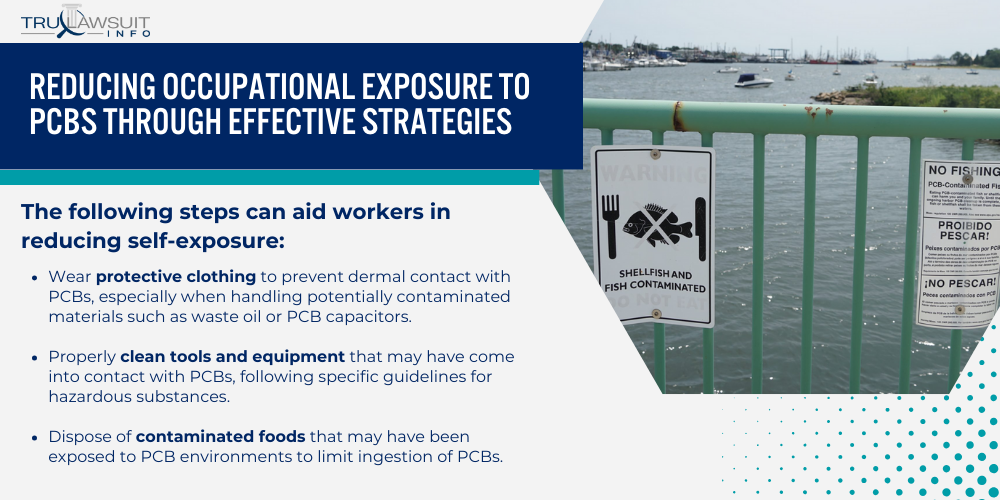
Strategies must be specific and robust to ensure safety.
Strategies for Self-Implemented Cleanups to Reduce PCB Exposure
Preventative measures at the individual level are essential in mitigating risk when dealing with PCBs.
The following steps can aid workers in reducing self-exposure:
- Wear protective clothing to prevent dermal contact with PCBs, especially when handling potentially contaminated materials such as waste oil or PCB capacitors.
- Properly clean tools and equipment that may have come into contact with PCBs, following specific guidelines for hazardous substances.
- Dispose of contaminated foods that may have been exposed to PCB environments to limit ingestion of PCBs.
- Regularly attend safety training to stay informed on the latest best practices for handling and clean-ups of PCBs.
Implementing these practices can greatly impact the safety of workers in environments where PCBs might be present.
Incorporating Worker Health in Performance and Risk-Based Cleanup
Focusing on worker health is paramount when planning and conducting PCB clean-up operations.
Here is how worker safety can be integrated into the process:
- Assess the presence of PCBs, noting the number of chlorine atoms, to understand the potential hazards.
- Monitor air and surface samples regularly to detect and quantify PCB presence in work environments.
- Establish workplace regulations that limit time spent in areas of particular concern where PCB exposure might be highest.
- Require the use of respirators and ventilation systems in areas where airborne PCBs present a significant health risk.
Making health a central part of the performance and risk-based cleanup protocols can effectively safeguard against occupational exposure.
Ensuring Worker Insurance Rights for PCB Exposure Cases
Worker insurance rights must be upheld, especially in situations where PCB exposure might lead to health complications.
Some crucial steps include:
- Confirm that workers’ compensation covers illnesses related to PCB exposure.
- Maintain up-to-date records of exposure incidents to streamline claims processes.
- Ensure that workers are aware of their right to seek medical evaluations following potential PCB exposure.
- Advocate for policies that support workers affected by PCBs, incorporating legal counseling if necessary.
Ensure that worker insurance rights are clear and enforced. This will prioritize the well-being of workers, even after exposure.
Safe PCB Waste Handling Practices to Prevent Occupational Exposure
Implementing safe waste handling practices is essential to prevent occupational exposure when dealing with polychlorinated biphenyls (PCBs), especially considering the potential for exposure through skin contact, the presence of PCBs in dairy products, and their impact on aquatic organisms.

High-Temperature Incineration Practices to Limit PCB Exposure
High-temperature incineration is recognized as an effective method for destroying PCBs and reducing the risk of exposure.
Proper incineration converts these toxic substances into less harmful compounds.
Key aspects of this approach include:
- Attaining temperatures above 1200°C to ensure the complete breakdown of PCBs.
- Continuous monitoring to maintain minimum dwell times for effective destruction.
- Advanced scrubber systems are installed to capture any residual compounds.
- Regular maintenance and inspection of incinerator equipment to prevent low concentrations of PCBs from escaping.
These practices help to minimize occupational exposure by ensuring that PCBs are completely destroyed and not released into the aquatic environment during the disposal process.
Alternative Disposal Methods to Mitigate Exposure to PCBs
While incineration is effective, other disposal methods also contribute to mitigating the risk of PCB exposure in the workplace.
These methods include:
- Chemical dechlorination neutralizes PCBs by replacing chlorine atoms with hydrogen.
- Secure landfilling involves isolating PCB waste from the environment to prevent contamination.
- High-efficiency plasma arc destruction, which uses intense heat generated by an electric arc.
- Non-combustion physical methods like encapsulation or vitrification.
These techniques provide options for safe disposal that reduce the potential for skin contact and environmental release.
Coordinated Safety Measures in PCB Disposal Processes
For safe PCB waste handling, coordinated safety measures must be in place.
These measures are designed to protect workers and adhere to regulations outlined by agencies such as the US EPA.
Essential safety measures are:
- Comprehensive training for personnel on safe handling and emergency procedures.
- Use of personal protective equipment (PPE) to prevent dermal and inhalation exposure.
- Implementation of decontamination procedures for equipment and work areas.
- Monitoring serum concentrations in workers to detect any occupational exposure to PCBs.
Coordinated efforts ensure that everyone involved in PCB disposal knows potential hazards and how to manage them, thus maintaining safety and compliance with health standards.
Streamlined Approvals for Cleanup to Lower Exposure to PCBs
Effective management of PCB cleanup streamlines application processes and directs EPA decisions toward minimizing occupational exposure to PCBs.
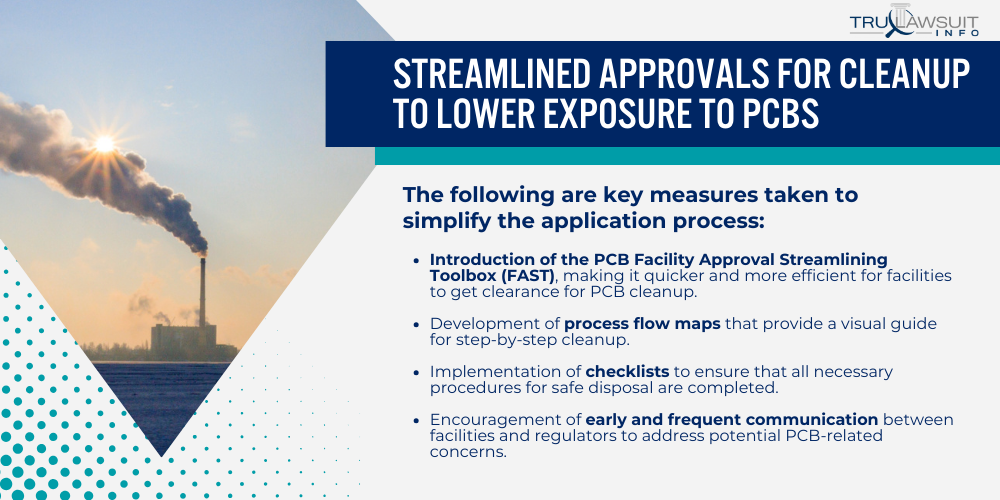
These efforts are aligned with improving workplace safety and preventing PCBs from entering the food chain.
Simplifying Application Processes with Focus on PCB Exposure Prevention
To better protect workers from PCB exposure, the application process for site cleanup has been simplified.
This simplification aims to prevent PCBs from becoming a health hazard, especially in workplaces with fluorescent lighting fixtures that may contain PCBs.
The following are key measures taken to simplify the application process:
- Introduction of the PCB Facility Approval Streamlining Toolbox (FAST), making it quicker and more efficient for facilities to get clearance for PCB cleanup.
- Development of process flow maps that provide a visual guide for step-by-step cleanup.
- Implementation of checklists to ensure that all necessary procedures for safe disposal are completed.
- Encouragement of early and frequent communication between facilities and regulators to address potential PCB-related concerns.
These measures enhance the efficiency of PCB site cleanup approvals, facilitating faster removal and safe disposal.
Consequently, workers’ exposure to PCBs is reduced, especially during maintenance tasks that might disturb older fixtures or equipment.
Influencing EPA Decisions to Favor Reduced Workplace PCB Exposure
Decisions made by the EPA significantly impact the rate and effectiveness of PCB cleanups.
Focusing on swift response to PCB contamination plays a crucial part in reducing the likelihood of PCBs entering the workplace or the food chain.
Strategies influencing EPA decisions towards lessened PCB exposure include:
- Prioritizing cleanup projects in facilities with high risks of PCB exposure, such as those with aging electrical components.
- Supporting research on the effects of PCB exposure to push for expedited approval processes.
- Providing guidance on managing remediation waste, including instructions on safe cleanup and disposal practices.
- Emphasizing the importance of physical examinations for workers in PCB-contaminated areas, ensuring early detection and mitigation of exposure-related health issues.
These EPA-directed interventions not only safeguard the health of employees but also maintain the overall safety of associated environments.
Through the application of these strategies, the risks presented by PCBs in occupational settings are considerably lowered.
Emergency Response Protocols for PCB Exposure in the Workplace
In the event of PCB exposure in the workplace, swift and informed action is necessary to mitigate health risks, including potential liver damage and reproductive and immune system effects.
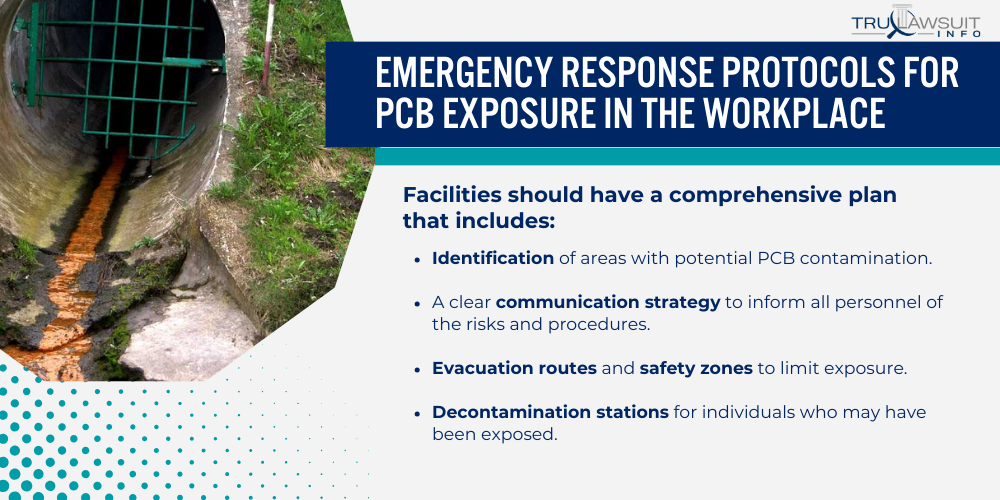
These protocols aim to protect national health by addressing critical response procedures.
Developing PCB Waste Management Plans Post-Disasters
Preparation is key to managing PCB waste after disasters effectively.
Facilities should have a comprehensive plan that includes:
- Identification of areas with potential PCB contamination.
- A clear communication strategy to inform all personnel of the risks and procedures.
- Evacuation routes and safety zones to limit exposure.
- Decontamination stations for individuals who may have been exposed.
Following an incident, prompt clean-up and disposal are essential to minimize health risks.
Guidelines for Handling PCB-Contaminated Equipment Safely
PCBs (Polychlorinated Biphenyls) are hazardous materials that can cause health problems if inhaled or ingested.
If you suspect you have equipment containing PCBs, it’s crucial to take steps to minimize the risk of exposure.
Handling equipment potentially contaminated with PCBs requires specific safety measures to prevent exposure:
- Use protective clothing such as special PCB-resistant gloves and suits.
- Implement engineering controls to contain or isolate PCBs.
- Ensure adequate ventilation or provide approved respirators when ventilation is not possible.
- Regular monitoring of air quality in areas known to be at risk.
Training for workers is essential to ensure they are informed on procedures for handling PCB-contaminated equipment.
Details on safe handling guidelines can be found in official documents provided by the National Institute for Occupational Safety and Health (NIOSH).
Legal Protections Against Workplace PCB Exposure Hazards
The regulatory landscape is instrumental in safeguarding workers from the dangers of prolonged PCB exposure.
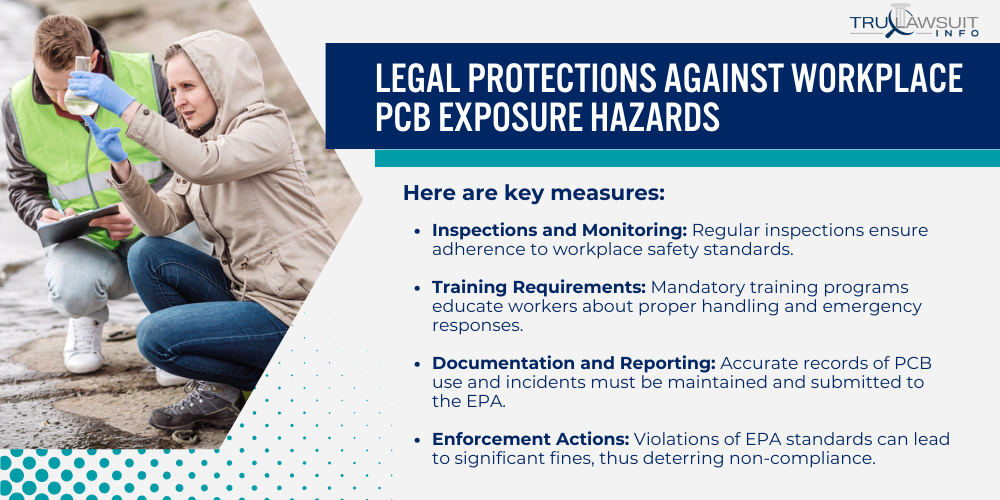
Specific rules have been established to mitigate exposure in the workplace and ensure the well-being of employees involved.
Enhancing EPA Policies to Address PCB Exposure Violations
The Environmental Protection Agency (EPA) has established comprehensive guidelines to control and enforce the proper handling of polychlorinated biphenyls (PCBs) in the workplace.
Workers should be made aware of the policies in place that protect their health, environment, and the legal repercussions of violations.
Here are key measures:
- Inspections and Monitoring: Regular inspections ensure adherence to workplace safety standards.
- Training Requirements: Mandatory training programs educate workers about proper handling and emergency responses.
- Documentation and Reporting: Accurate records of PCB use and incidents must be maintained and submitted to the EPA.
- Enforcement Actions: Violations of EPA standards can lead to significant fines, thus deterring non-compliance.
Fair Treatment and Protection for Workers Exposed to PCBs
Employers bear the responsibility of providing a safe workplace environment, particularly when there is a risk of PCB exposure.
Protections for workers include:
- Occupational Safety and Health Administration (OSHA) Regulations: OSHA sets limits on workplace exposure to PCBs, protecting workers’ health.
- Right-to-Know Laws: These laws require employers to inform workers about the presence of PCBs in the workplace.
- Medical Surveillance Programs: Programs for ongoing health monitoring of workers exposed to PCBs.
- Workers’ Compensation: Financial and medical assistance for workers who fall ill due to PCB exposure.
Epidemiological studies that have established connections between PCB exposure and various health effects underscore these protections, supporting the need for stringent, enforceable regulations.
Enhancing Workplace Safety Through Comprehensive PCB Exposure Management
Effective management of exposure to polychlorinated biphenyls (PCBs) in the workplace is paramount to safeguarding worker health.
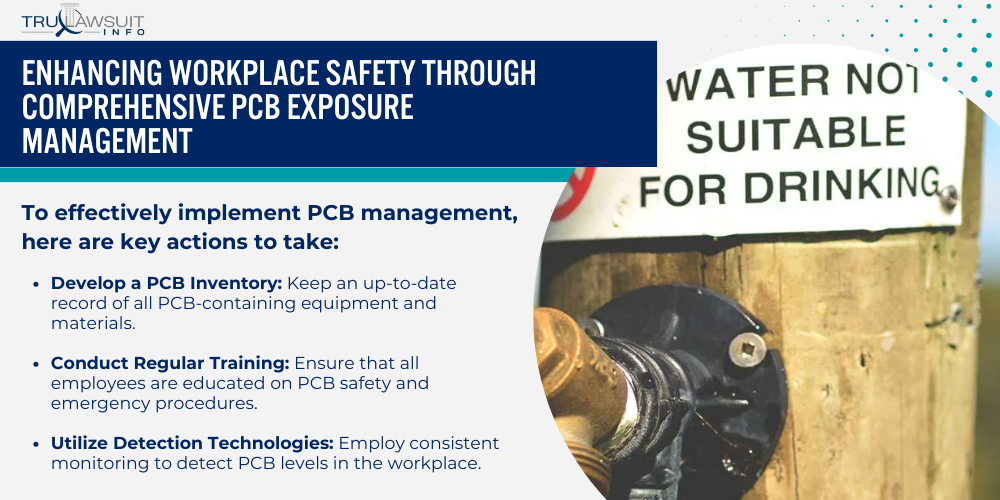
Companies should consider implementing robust PCB management programs that include tracking initiatives, ensuring thorough cleanups, and promoting greener practices to enhance workplace safety.
Tracking PCB Management Initiatives to Safeguard Worker Health
Tracking PCB management initiatives is integral to maintaining a safe working environment.
Regular monitoring and evaluation can pinpoint areas needing improvement and confirm the effectiveness of safety protocols.
To effectively implement PCB management, here are key actions to take:
- Develop a PCB Inventory: Keep an up-to-date record of all PCB-containing equipment and materials.
- Conduct Regular Training: Ensure that all employees are educated on PCB safety and emergency procedures.
- Utilize Detection Technologies: Employ consistent monitoring to detect PCB levels in the workplace.
Ensuring Thorough Cleanup to Minimize Occupational PCB Exposure
Minimizing occupational PCB exposure through thorough cleanup is essential to reduce the risk of contamination and protect worker health.
To ensure a thorough cleanup and minimize PCB exposure, here are key steps to take:
- Implement Decontamination Protocols: Establish clear guidelines for handling and disposing of PCB-containing materials.
- Engage Professional Cleanup Services: Utilize certified experts for the removal and disposal of PCBs as recommended by NIOSH.
- Monitor Cleanup Efficacy: Regularly test the environment post-cleanup to ensure all PCBs have been effectively removed.
Promoting Greener Cleanup Practices for Healthier Work Environments
Greener cleanup practices benefit the environment and contribute to healthier workspaces.
Some key strategies to implement greener cleanup practices:
- Adopt Sustainable Materials: Replace PCB-containing materials with eco-friendly alternatives.
- Invest in Green Technologies: Use advanced, less invasive methods for cleaning and maintenance.
- Educate on Green Practices: Encourage employee awareness and participation in environmental sustainability efforts.
Frequently Asked Questions
-
Exposure to PCBs in the workplace has been associated with various health effects, including skin conditions and potential cancer risks.
Learn more about health effects from the Agency for Toxic Substances and Disease Registry’s insight on adverse health effects of PCB exposure.
-
PCBs may still be encountered in older equipment or during an accidental release.
The primary exposure routes are inhalation and skin contact, particularly during maintenance or repair tasks.
The Agency for Toxic Substances and Disease Registry provides detailed routes of exposure for PCBs.
-
Employers should ensure proper safety training and provide personal protective equipment.
Workplaces should also have protocols for handling and disposing of PCB materials.
The importance of such safety measures is reinforced by information on the EPA’s site regarding PCB handling.
-
Regulations set by agencies such as the EPA and OSHA outline specific exposure limits and guidelines.
The EPA provides extensive information on PCB regulations, which can be accessed in their Polychlorinated Biphenyls (PCBs) Fact Sheet.
-
Regular air monitoring, risk assessments, and records of PCB levels in the workplace are essential.
These practices help ensure the work environment remains within safe exposure limits.
For further understanding of exposure control, the EPA’s guidelines are a useful resource.
-
In the event of accidental exposure, contaminated clothing should be removed and affected skin cleaned thoroughly.
Reporting the accident and seeking medical attention are required steps.
The incident protocol is elaborated in the Public Health discussion on Polychlorinated Biphenyls (PCBs).

Attorney Jessie Paluch, founder of TruLawsuit Info, has over 25 years of experience as a personal injury and mass tort attorney, and previously worked as an international tax attorney at Deloitte. Jessie collaborates with attorneys nationwide — enabling her to share reliable, up-to-date legal information with our readers.
Legally Reviewed
This article has been written and reviewed for legal accuracy and clarity by the team of writers and legal experts at TruLawsuit Info and is as accurate as possible. This content should not be taken as legal advice from an attorney. If you would like to learn more about our owner and experienced injury lawyer, Jessie Paluch, you can do so here.
Fact-Checked
TruLawsuit Info does everything possible to make sure the information in this article is up to date and accurate. If you need specific legal advice about your case, contact our team by using the chat on the bottom of this page. This article should not be taken as advice from an attorney.
You can learn more about the PCB Exposure Lawsuit by visiting any of our pages listed below:
Here, at Tru Lawsuit Info, we’re committed to helping victims get the justice they deserve.
To do this, we actively work to connect them with attorneys who are experts in litigating cases similar to theirs.
Table of Contents
Tru Lawsuit Info is a reliable source of information about issues that may affect your health and safety, such as faulty products, data breaches, and environmental hazards.
Our team of experienced writers collaborates with medical professionals, lawyers, and advocates to produce informative articles, guides, and other resources that raise awareness of these topics.
Our thorough research provides consumers with access to reliable information and updates on lawsuits happening around the country. We also can connect consumers with attorneys if they need assistance.
Here, at Tru Lawsuit Info, we’re committed to helping victims get the justice they deserve.
To do this, we actively work to connect them with attorneys who are experts in litigating cases similar to theirs.
